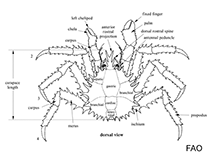Lithodes santolla (Molina, 1782)
Southern king crab| Native range | All suitable habitat | Point map | Year 2050 |

|
| This map was computer-generated and has not yet been reviewed. |
| Lithodes santolla AquaMaps Data sources: GBIF OBIS |
Google image | No image available for this species;
drawing shows typical species in Lithodidae.
Classification / Names Common names | Synonyms | CoL | ITIS | WoRMS
Malacostraca | Decapoda | Lithodidae | Lithodinae
Environment: milieu / climate zone / depth range / distribution range Ecology
Benthic; depth range 0 - 700 m (Ref. 2686). Subtropical, preferred 9°C (Ref. 107945); 34°S - 57°S, 77°W - 51°W
Distribution Countries | FAO areas | Ecosystems | Occurrences | Introductions
Southeast Pacific and Southwest Atlantic: from Chile (Talcahuano to Cape Horn), Falkland Islands, Argentina and Uruguay. Subtropical and temperate.
Length at first maturity / Size / Weight / Age
Maturity: Lm ?, range 6 - 7.5 cm Max length : 19.0 cm CL male/unsexed; (Ref. 93013); max. published weight: 8.0 kg (Ref. 93013)
Life cycle and mating behavior Maturity | Reproduction | Spawning | Eggs | Fecundity | Larvae
Main reference
References | Coordinator | Collaborators
Arana, P.M.E. and M.A. Retamal 1999 Nueva distribución de Paralomis birsteini Macpherson, 1988 en aguas antárcticas (Anomura, Lithodidae, Lithodinae). Invest. Mar, Valparaíso 27:101-110. (Ref. 2676)
IUCN Red List Status
(Ref. 130435: Version 2025-1)
CITES status (Ref. 108899)
CMS (Ref. 116361)
Threat to humans
Human uses
Fisheries: commercial
FAO - Fisheries: landings | FishSource | Sea Around Us
Tools
More information
Max. ages / sizes
Length-weight rel.
Length-length rel.
Length-frequencies
Mass conversion
Abundance
Internet sources
BHL | BOLD Systems | CISTI | DiscoverLife | FAO(Fisheries: ; publication : search) | Fishipedia | GenBank (genome, nucleotide) | GloBI | Gomexsi | Google Books | Google Scholar | Google | PubMed | Tree of Life | Wikipedia (Go, Search) | Zoological Record



